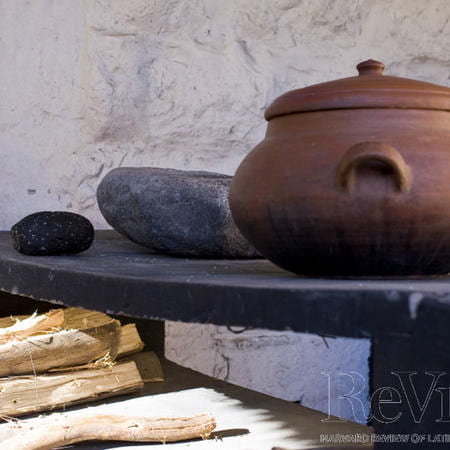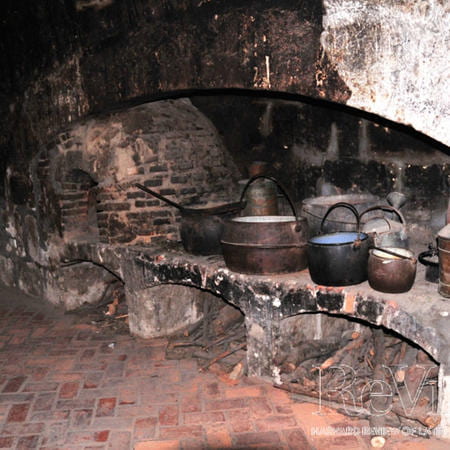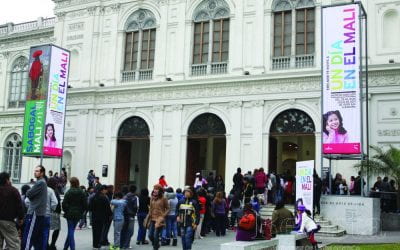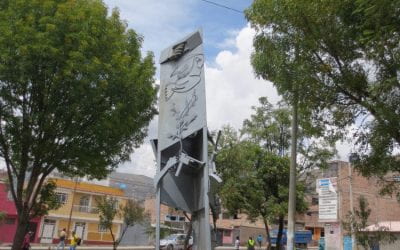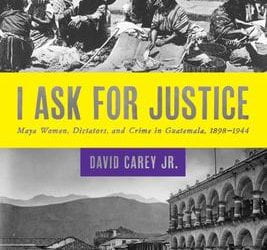Culinary Fusion and Colonialism
A Critical Look at the Peruvian Food Boom
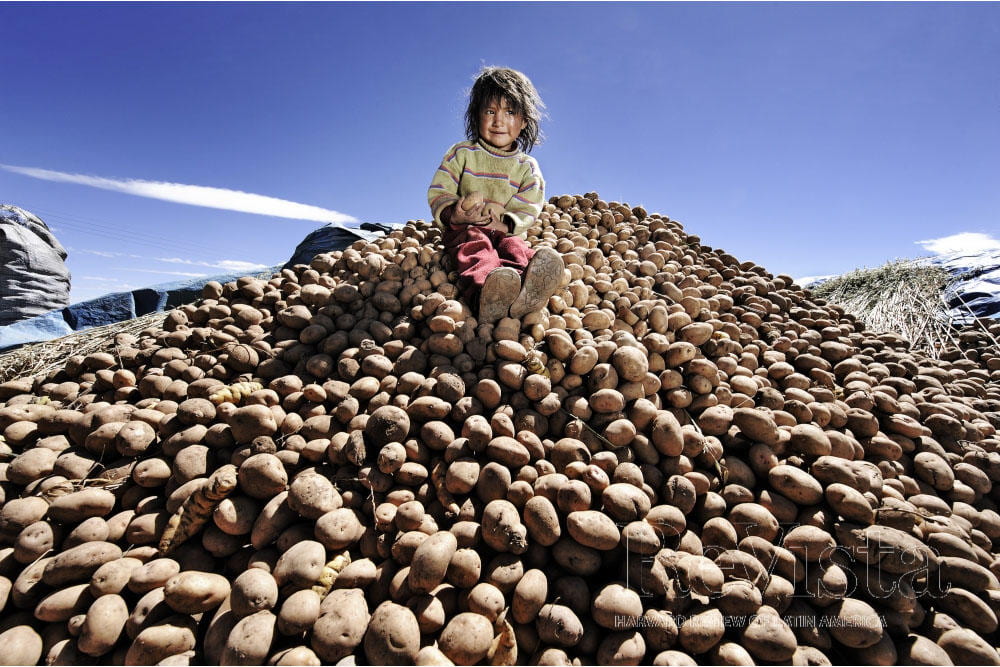
A child sits atop a mound of Peruvian potatoes. Photo by Luis H. Figueroa, Ojos Propios/Reniac, “Rostros del Perú.”
- Cooking stove at a typical eating place known as a picantería. Photo courtesy of Angel Amy Moreno.
- A colonial-style kitchen. Photo courtesy of Angel Amy Moreno.
- Large jars to hold water. Photo courtesy of Angel Amy Moreno.
Gastón Acurio, perhaps the best-known public figure in Peru, informs his viewers in Patricia Perez’ documentary, Mistura: The Power of Food (2011) that his mission is to “create the most beautiful restaurants in the world’s most beautiful cities.” Acurio studied culinary arts in Madrid and Paris, but since his return to Peru in the mid-1990s, a period that coincided with the end of an armed conflict between the state and leftist insurgents, he has spearheaded the development of the “beautiful fusion” of indigenous Peruvian products. In an interview with Food & Wine, Acurio states, “Our mission isn’t just making restaurants. What we are doing, really, is selling a country.”
Apega, the Peruvian Society of Gastronomy created in 2007, is a key actor in the marketing and selling of Peruvian food and culture (and nation). According to its website, it seeks to “build bridges of harmony between our peoples by revaluing the role of the producer in the food chain. Apega is the place where chefs and peasants…are all equal; we want to cook the same thing: Peru’s progress.” Apega promises “inclusion, quality, cultural identity, and biodiversity,” and is charged with planning and executing the largest culinary festival in Latin America, Mistura.
In February 2012, I spoke with Mariano Valderrama, Apega’s executive director, in his Lima office. We had an interesting conversation about food, social inclusion and tourism, but his focus was on the challenges Apega faced in transforming Lima into Latin America’s gastronomic capital. Valderrama was especially preoccupied with what he called “the problem of hygiene.” For example, Valderrama insisted on the need for “cleaning up Peruvian markets” so that tourists could “comfortably and hygienically stroll through our colorful markets.” During Mistura, Apega deploys “hygiene brigades” to ensure the cleanliness of food stands, eating areas and festival workers. He blamed municipalities for “not enforcing hygiene standards in markets,” citing this as one of the biggest obstacles to Apega’s work. “Our most representative market, La Parada, is Calcutta.” The connection Valderrama makes between Lima’s unclean markets and one of India’s largest cities reveals assumptions about uneven development and racialized understandings around hygiene.
Nevertheless, Valderrama was clearly proud of Apega’s work toward social inclusion, repeatedly mentioning the “alliance” between chefs and producers promoted by Apega, Acurio and others. Apega finances publications that highlight native products such as potatoes, quinoa and ají, and sponsors media trips to “zones of production” so that Peruvians can learn where products come from and who produces them: “This is about elevating the product, and elevating the self-esteem of the producer.” After years of political upheaval and economic depression, he said, “there is an increasing optimism in Peru that is about valuing cultural identity. Many Peruvians with whom I have spoken agree with this sentiment and note that the ongoing gastronomic revolution is one of the few things bringing Peruvians together.”
Gourmet describes Lima as the “next stop” for sophisticated food and Food & Wine touts Peru’s “world-class cuisine.” Tourists now travel to Lima regularly for “a taste of Peru,” or as one website puts it, “a culinary journey to the land of the Incas.” These culinary adventurers are of course looking for the exotic and beautiful packaging of tradition and authenticity—precisely what Valderrama and Acurio are trying to sell. In this sense, novoandino cuisine is an exportable and sophisticated version of what was previously regarded as local and backward. In an interview with Gourmet, one of Acurio’s childhood friends makes this point: “‘When I grew up, if you ate guinea pig you were a savage,’ [he] says, biting into a leg of roasted organic guinea pig nestled in its bed of oca ravioli in a pecan sauce with Pisco.”
The development of “alternative” traditional dishes has been an important strategy in this move from “savage” to “sophisticated” cuisine. High-end tourists may want to taste guinea pig, for example, but a roasted guinea pig served whole on a plate, with eyes, teeth, nails and even charred hair is unappealing to Europeans and North Americans. Thus, Acurio and other chefs design dishes that retain exotic and traditional ingredients, yet render these same products invisible. Serving ravioli stuffed with guinea pig meat allows tourists to taste a “traditional” animal without actually having to see it. It also emphasizes mistura, or “beautiful fusion” as Acurio describes it in Perez’ documentary: “The word mistura means mixture, but Mistura [the festival] is a pretty mixture. Peruvian cuisine is a beautiful mixture.” In another documentary directed by Ernesto Cabellos’ (De Ollas y Sueños, 2009), Acurio describes the current moment, “when fusion is a tendency throughout the world, when integration, globalization,…become modern concepts, Peruvian cuisine appears, having fused cultures but in a very balanced, very reflexive, very consensual way over the last 500 years, and this is what makes it magical, what makes it so attractive” (my emphasis).
Acurio cheerfully presents Peru as an exemplary nation, in which the cuisine has performed something magical, “balanced” and “consensual.” While such a statement is, of course, too good to be true—the violence of the last 500 years, not to mention the last 30 years, was hardly balanced or consensual—as a way to commodify Peruvian history and food, it is nothing short of brilliant. Indeed, one of Acurio’s strengths is to perform his own kind of magic in which the antagonisms of history and politics disappear.
Acurio promotes what he calls “a culinary ethics that goes beyond mere pleasure.” He insists that this culinary movement must be guided by ethical principles that account for where food comes from and who benefits from its consumption. Using local ingredients, celebrating native producers and training chefs from poor socioeconomic backgrounds, Acurio places ethics and aesthetics on the same plate: “Gastronomy and hunger simply do not go together. It is immoral to enjoy good food and lavish meals when you know that the fisherman who caught your divinely cooked seafood lives in a shabby hut and must survive on next to nothing.”
For Peru’s gastronomic society, all this is the stuff of culinary and economic success. In a short promotional video for Mistura, Apega makes its case for the inclusive moment of culinary entrepreneurialism, and celebrates Lima as a “city where the dreams of a few are becoming the reality for all; the dream of a small group of chefs….together with an emerging army of chefs in training, and the work of Apega, has spread to an entire nation.” Apega’s website describes Mistura almost in the language of German philosopher Jürgen Habermas’ public sphere, where “differences are left at the door.” Yet, as Nancy Fraser notes in her 1990 critique, the “bracketing” of social difference “usually works to the advantage of dominant groups in society and to the disadvantage of subordinates.” She uses Habermas’ notion of the public sphere to examine why these ideas—shared by Apega—do not go far enough: they neglect the fact that real public spheres, as Fraser explains, are often made up of a “number of significant exclusions.”
Hidden Worlds
Indigenous perspectives on these culinary developments are much less audible than those of chefs and public intellectuals. The indigenous organization in Peru that has perhaps carried out the most work on food is Chirapaq, The Center of Indigenous Cultures in Peru. An influential organization that specializes in work with indigenous women, food sovereignty and security, and the recovery and revalorization of ancestral knowledge, Chirapaq collaborates closely with communities in Ayacucho, the highland department most affected by the political violence of the 1980s and 1990s.
On a very hot February day in 2012, I walked into Chirapaq’s office and spoke with a few indigenous activists. When I asked one activist (whom I’ll call Nelson) about Chirapaq’s work on food sovereignty and about the gastronomic boom, he smiled. Nelson seemed surprised that I asked about the boom, which “Chirapaq doesn’t do….[it] goes against everything we do.” Another activist, who used the pseudonym of Rendón, was also surprised that I was asking about “the boom” in an indigenous cultural center. That sense of surprise itself suggested the limits of the inclusionary rhetoric of novoandino cuisine, which was not seen as including Chirapaq but rather as working against it. To understand this disconnect between the promises of inclusion and understandings of exclusion, it is helpful to consider the words of Peruvian chef Adolfo Perret, who told Peru’s leading newspaper El Comercio:
One of the most spectacular things that the chefs of this country have done is the alliance between agricultural producers and chefs. Thanks to this we can see that social inclusion is real and it is a way for them [producers] to also deserve the applause that we [chefs] have obtained with the dishes of Peruvian cuisine.
This comment illustrates some of the concerns that Chirapaq and other indigenous critics have raised about the paternalistic claims to social inclusion: “We” (urban mestizo chefs) have done this good deed in creating and promoting an alliance with “them” (rural indigenous producers); because “we” are willing to share our applause and recognize “their” participation in our creation of delicious Peruvian dishes, social inclusion exists. Good intentions notwithstanding, this social alliance anchors indigenous peoples in certain places. They are producers, not chefs, or street vendors, and never celebrities. Social hierarchies remain remarkably unaltered by the magical space of Mistura. If anything, they are repackaged in glossy promotional materials that celebrate “a unique space where an entire nation feels harmoniously integrated.”
The people I spoke with at Chirapaq did not feel harmoniously integrated. Discussing Peruvian gastronomy, Rendón shared three main concerns. The first related to negative health effects that come from not knowing the nutritional and medicinal value of traditional Andean foods. Second, he discussed the disturbing trend of young people moving away from traditional nourishment and toward the processed and industrialized “food” of fast food chains. Finally, he expressed concerns about economic disruption caused by some chefs working with only certain producers to the detriment of others.
According to people I spoke with at Chirapaq, the gastronomic boom in Peru goes directly against their work in revalorizing and decolonizing Andean diets. The changing trends celebrate a few iconic Andean and Amazonian products—quinoa, awaymanto—which ironically serve to raise the price of these goods, making them less accessible to many rural communities, and encouraging producers to focus on a narrow range of goods to supply the growing demand.
Rendón added that concerns about infringement of native intellectual property were lost in the celebratory discourse. Furthermore, indigenous people were not being seen or heard in the most recent boom. Where, Rendón asked, are indigenous peoples in this revolution? Nelson then added to the conversation by asking, “What is the Peru that ‘marca [brand] Peru’ is selling?”
As a partial response, Chirapaq was planning what Rendón reluctantly described as “a gastronomic festival.” He was hesitant because the gathering is about much more than gastronomy. The event, to take place in Ayacucho, is intended to promote ancestral agricultural, medicinal and culinary practices. It is not just about flavors or aesthetics but also about nutrition and health, and it will feature elders, the knowledge producers of indigenous communities. Rendón emphasized the need for intergenerational transmission of knowledge, as without this it would be impossible to move forward since young people need to continue with these traditions. Finally, the event is not for tourists, nor is it about competing with Mistura. Rather it provides an alternative space for indigenous people to talk and learn about indigenous foods.
If Mistura aspired to be a Habermasian culinary public sphere, the alternative space in Ayacucho is closer to what Nancy Fraser calls “subaltern counterpublics,” or “parallel discursive arenas where members of subordinated social groups invent and circulate counterdiscourses to formulate oppositional interpretations of their identities, interests, and needs.” These spaces are not only parallel, as Fraser might say, but rather they are characterized by different logics. Moving from Habermasian terms to Andean ones, Rendón emphasized the importance of Andean cosmovisions for Chirapaq and indigenous communities. He told me that “the boom” offers no discussion of reciprocity, complementarity or harmony: “we can obtain the fruits of the Pachamama (mother earth), but we have to give back, provide a pago a la tierra (payment to the earth).” As anthropologist Marieka Sax has noted, even the practice of feeding has both significant secular and sacred purposes. Community members, mountain spirits and devils in mines all require feeding, the practice of which “articulates relationships between social others, and maintains relationships between the living and the dead; and the offering of food and drink to the mountain spirits, pachamama, saints, and other divine powers keeps their vitalizing and animating life-energy in circulation so as to ensure fertility, productivity, and well being.” How different this is from Mistura, where individual chefs are celebrated, and leisure and aesthetics—not reciprocity or religiosity—are the central logics.
Like all critiques, Chirapaq’s are contestable and there is no question that the chefs of Mistura would disagree with many of them. Moreover, rural producers and others connected to high-profile events such as Mistura certainly receive important material benefits. My purpose here is not to endorse all of Chirapaq’s claims, but rather to reveal some of what gets obscured if we only focus on the inclusionary promise of Mistura. In the now hegemonic discourse of the power of Peruvian food, there is a need to slow down and explore other consequences of this boom, especially on those populations and bodies that do not benefit from the festival of flavors.
Fall 2014, Volume XIV, Number 1
María Elena García is director of the Comparative History of Ideas and associate professor in the Jackson School of International Studies at the University of Washington. She received her Ph.D. in Anthropology at Brown University and has been a Mellon Fellow at Wesleyan University and Tufts University. Her first book, Making Indigenous Citizens: Identities, Development, and Multicultural Activism in Peru (Stanford, 2005), examines indigenous politics and multicultural activism in Peru. Her work on native and interspecies politics in the Andes has appeared in multiple edited volumes and journals. Her second book project, Dancing Guinea Pigs and Other Tales of Race in Peru, explores the lives and deaths of guinea pigs as one way to think about the cultural politics of contemporary Peru, especially in relation to food, indigenous politics and violence.
A longer version of this essay, in which the author examined the impact of the gastronomic boom on indigenous and non-human bodies, appeared as “The Taste of Conquest: Colonialism, Cosmopolitics, and the Dark Side of Peru’s Gastronomic Boom,” The Journal of Latin American and Caribbean Anthropology Vol. 18, No. 3, 2013. It is reprinted here with permission.
Related Articles
The Violence of the VIP Boxes
English + Español
In Peru, the upper class does not like to mix with those they consider different or inferior. Their maids on the beaches south of Lima are not allowed to swim in club pools and, sometimes, not even in the ocean. The VIP boxes at sports and theater events maintained by the government are a public display of a private practice that reproduces in the public sphere the worst aspect of private hierarchical structuring.
Peace and Reconciliation
English + Español
Eleven years have gone by since the Peruvian Truth and Reconciliation Commission presented its final report. The report reconstructed the history of many cases of massacres, tortures, murders and other serious crimes. At the same time, it contributed an interpretation of the…
I Ask for Justice: Maya Women, Dictators, and Crime in Guatemala, 1898–1944
On May 10, 2013, General Efraín Ríos Montt sat before a packed courtroom in Guatemala City listening to a three-judge panel convict him of genocide and crimes against humanity. The conviction, which mandated an 80-year prison sentence for the octogenarian, followed five weeks of hearings that included testimony by more than 90 survivors from the Ixil region of the department of El Quiché, experts from a range of academic fields, and military officials.

